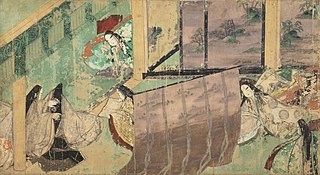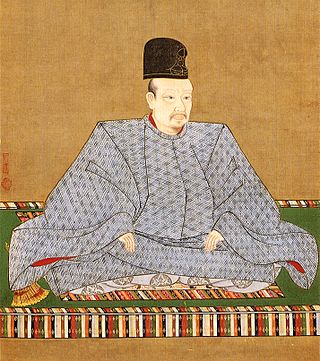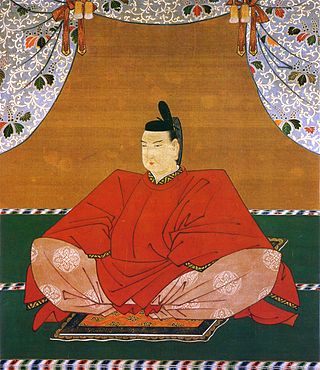Works published
| | This section is empty. You can help by adding to it. (July 2010) |
| |||
|---|---|---|---|
| +... |
| | This section is empty. You can help by adding to it. (July 2010) |
| | This section is empty. You can help by adding to it. (July 2010) |

Emperor Kanmu, or Kammu, was the 50th emperor of Japan, according to the traditional order of succession. Kammu reigned from 781 to 806, and it was during his reign that the scope of the emperor's powers reached its peak.

The Fujiwara clan was a powerful family of imperial regents in Japan, descending from the Nakatomi clan and, as legend held, through them their ancestral god Ame-no-Koyane. The Fujiwara prospered since the ancient times and dominated the imperial court until the Meiji Restoration in 1868. They held the title of Ason. The abbreviated form is Tōshi (藤氏).

The Heian period is the last division of classical Japanese history, running from 794 to 1185. It followed the Nara period, beginning when the 50th emperor, Emperor Kammu, moved the capital of Japan to Heian-kyō. Heian (平安) means 'peace' in Japanese. It is a period in Japanese history when the Chinese influences were in decline and the national culture matured. The Heian period is also considered the peak of the Japanese imperial court, noted for its art, especially poetry and literature. Two syllabaries unique to Japan, katakana and hiragana, emerged during this time. This gave rise to Japan's famous vernacular literature, with many of its texts written by court women who were not as educated in Chinese as their male counterparts.

Emperor Go-Yōzei was the 107th Emperor of Japan, according to the traditional order of succession. Go-Yōzei's reign spanned the years 1586 through to his abdication in 1611, corresponding to the transition between the Azuchi–Momoyama period and the Edo period.

Emperor Go-Hanazono was the 102nd emperor of Japan, according to the traditional order of succession. His reign spanned the years from 1428 through 1464.
Emperor Reizei was the 63rd emperor of Japan, according to the traditional order of succession.

Emperor Daigo was the 60th emperor of Japan, according to the traditional order of succession.

Emperor Ōgimachi was the 106th Emperor of Japan, according to the traditional order of succession. He reigned from November 17, 1557, to his abdication on December 17, 1586, corresponding to the transition between the Sengoku period and the Azuchi–Momoyama period. His personal name was Michihito (方仁).

Emperor Ichijō was the 66th emperor of Japan, according to the traditional order of succession.
This is a list of Japanese clans. The old clans (gōzoku) mentioned in the Nihon Shoki and Kojiki lost their political power before the Heian period, during which new aristocracies and families, kuge, emerged in their place. After the Heian period, the samurai warrior clans gradually increased in importance and power until they came to dominate the country after the founding of the first shogunate.

In Japan, Sesshō (摂政) was a regent who was named to act on behalf of either a child emperor before his coming of age, or an empress regnant. The Kampaku (関白) was theoretically a sort of chief advisor for the Emperor, but was in practice the title of both first secretary and regent who assisted an adult Emperor. The duties of the Sesshō and Kampaku were to convey to the Emperor the policies formulated by the Sadaijin and other senior officials of the Daijō-kan, and to convey the Emperor's decisions to them. As regents of the Emperor, the Sesshō and Kampaku sometimes made decisions on behalf of the Emperor, but their positions were not defined by law and they had no specific political authority. The two titles were collectively known as sekkan (摂関), and the families that exclusively held the titles were called sekkan-ke.
Fujiwara no Kamatari, also known as Nakatomi no Kamatari, was a Japanese politician and aristocrat who, together with Prince Naka no Ōe, carried out the Taika Reform. He was the founder of the Fujiwara clan, the most powerful aristocratic family in Japan during the Nara and Heian periods. He, along with the Mononobe clan, was a supporter of Shinto and fought the introduction of Buddhism to Japan. The Soga clan, defenders of Buddhism in the Asuka period, defeated Kamatari and the Mononobe clan, and Buddhism became the dominant religion of the Imperial Court. Kamatari was appointed Inner Minister, and, along with Prince Naka no Ōe, later Emperor Tenji (626–672), launched the Taika Reform of 645, which centralized and strengthened the central government. Just before his death, he received the surname Fujiwara and the rank Taishōkan from Emperor Tenji, thus establishing the Fujiwara clan.
Fujiwara no Morozane was a regent of Japan and a chief of the Fujiwara clan during the late Heian period. He was known as Kyōgoku dono or Go-Uji dono. He held the positions of sessho or kanpaku for a twenty-year period, sessho from 1075 to 1086 during the reign of Emperor Shirakawa and from 1094 to 1099 during the reign of Emperor Horikawa, and kampaku from 1086 to 1094 during the reign of Emperor Horikawa.
Yoshiaki Fujiwara is a Japanese professional wrestler, trainer and wrestling promoter. He is famous for his long career in wrestling, having worked in New Japan Pro-Wrestling (NJPW), Pro Wrestling ZERO-ONE (ZERO-ONE), and the two incarnations of shoot style promotion Universal Wrestling Federation. Fujiwara is known for his catch wrestling expertise, having been praised by fighters like Josh Barnett and Ken Shamrock. He was trained by Karl Gotch and has trained many MMA fighters and professional wrestlers. Fujiwara also has a strong background in Judo and Muay Thai.

Tatsuya Fujiwara is a Japanese actor. Internationally, he is best known for his leading roles as Shuya Nanahara in the Battle Royale films, Light Yagami in the Death Note films, Kaiji Itō in the Kaiji films, and Rikuhiko Yuki in Hideo Nakata's The Incite Mill. In 2014, he portrayed the villain Shishio Makoto in the live action Rurouni Kenshin films.

Rika Fujiwara is a Japanese former tennis player.

The Thirty-Six Immortals of Poetry are a group of Japanese poets of the Asuka, Nara, and Heian periods selected by Fujiwara no Kintō as exemplars of Japanese poetic ability. The oldest surviving collection of the 36 poets' works is Nishi Honganji Sanju-rokunin Kashu of 1113. Similar groups of Japanese poets include the Kamakura period Nyōbō Sanjūrokkasen (女房三十六歌仙), composed by court ladies exclusively, and the Chūko Sanjūrokkasen (中古三十六歌仙), or Thirty-Six Heian-era Immortals of Poetry, selected by Fujiwara no Norikane (1107–1165). This list superseded an older group called the Six Immortals of Poetry.
Tokuro Fujiwara, sometimes credited as Professor F or Arthur King, is a Japanese video game designer, involved in the development of many classic Capcom video games. He directed early Capcom titles such as the run-and-gun shooter Commando (1985), the platformers Ghosts 'n Goblins (1985) and Bionic Commando (1987), and the survival horror game Sweet Home (1989). He was also a main producer for the Mega Man series and worked on the CP System arcade game Strider (1989). He also conceived of Resident Evil as a remake of his earlier game Sweet Home and worked on the game as general producer. He worked as the general manager of the Capcom Console Games Division from 1988 to 1996.
Naoya Fujiwara is a Japanese professional shogi player ranked 7-dan.